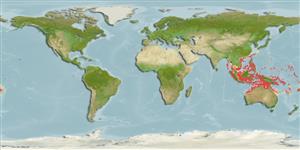>
Ovalentaria/misc (Various families in series Ovalentaria) >
Pomacentridae (Damselfishes) > Pomacentrinae
Etymology: Amblyglyphidodon: Greek, amblys = darkness + Greek, glyphis = carved + Greek, odous = teeth (Ref. 45335).
More on author: Cuvier.
Environment: milieu / climate zone / depth range / distribution range
Ecologia
marinhas associadas(os) a recifes; não migratória; intervalo de profundidade 0 - 60 m (Ref. 128797), usually 12 - 45 m (Ref. 9710). Tropical; 30°N - 24°S, 90°E - 174°W
Western Pacific: Andaman Sea (Ref. 7247) and Christmas Island in the eastern Indian Ocean to Fiji, north to the Ryukyu Islands, south to Rowly Shoals (eastern Indian Ocean)and New Caledonia. Recently recorded from Tonga (Ref. 53797).
Tamanho / Peso / Idade
Maturity: Lm ? range ? - ? cm
Max length : 13.0 cm TL macho/indeterminado; (Ref. 48636)
Descrição suscinta
Chaves de identificação | Morfologia | Morfometria
Espinhos dorsais (total) : 13; Raios dorsais (total) : 12 - 16; Espinhos anais: 2; Raios anais : 14 - 15.
Adults occur in steep outer reef, occasionally in deep lagoons and along channel walls, usually in current prone habitats and where there are abundant gorgonian and long sea-whip corals on which they lay and guard eggs. Juveniles in small groups often found among large sea fans or black corals. Feed on zooplankton (Ref. 7247). Oviparous, distinct pairing during breeding (Ref. 205). Eggs are demersal and adhere to the substrate (Ref. 205). Eggs laid usually on gorgonian dead branches (Ref. 90102). Males guard and aerate the eggs (Ref. 205).
Ciclo de vida ou comportamento de acasalamento
Maturities | Reprodução | Spawnings | Egg(s) | Fecundities | Larvas
Oviparous, distinct pairing during breeding (Ref. 205). Eggs are demersal and adhere to the substrate (Ref. 205). Males guard and aerate the eggs (Ref. 205).
Allen, G.R., 1991. Damselfishes of the world. Mergus Publishers, Melle, Germany. 271 p. (Ref. 7247)
Status na Lista Vermelha da UICN (Ref. 130435)
Ameaça para os humanos
Harmless
Uso pelos humanos
Pescarias: espécies comerciais; Aquário: Espécies comerciais
Ferramentas
Relatórios especiais
Baixar XML
Fontes da internet
Estimates based on models
Preferred temperature (Ref.
123201): 26.1 - 29, mean 28.1 °C (based on 904 cells).
Índice de diversidade filogenética (Ref.
82804): PD
50 = 0.5005 [Uniqueness, from 0.5 = low to 2.0 = high].
Bayesian length-weight: a=0.02344 (0.01149 - 0.04783), b=2.99 (2.82 - 3.16), in cm total length, based on LWR estimates for this (Sub)family-body shape (Ref.
93245).
Nível Trófico (Ref.
69278): 2.7 ±0.30 se; based on food items.
Resiliência (Ref.
120179): Elevada, tempo mínimo de duplicação da população menor que 15 meses (Preliminary K or Fecundity.).
Fishing Vulnerability (Ref.
59153): Low vulnerability (10 of 100).
Nutrients (Ref.
124155): Calcium = 96.8 [48.8, 148.6] mg/100g; Iron = 0.72 [0.45, 1.17] mg/100g; Protein = 18.2 [17.0, 19.3] %; Omega3 = 0.116 [0.072, 0.185] g/100g; Selenium = 27.1 [15.4, 48.9] μg/100g; VitaminA = 81.4 [22.0, 272.3] μg/100g; Zinc = 1.64 [1.13, 2.35] mg/100g (wet weight);
